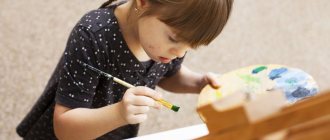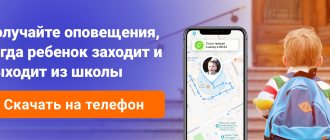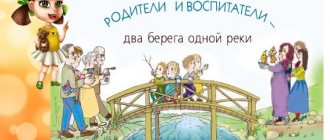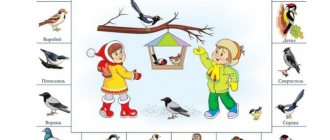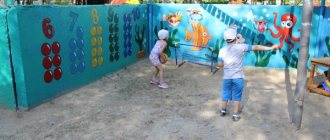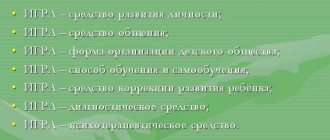Individual approach to raising and teaching a child in a kindergarten
The involvement of parents and other family members in the educational work of the kindergarten is necessary, first of all, for the children.
The success of cooperation largely depends on the mutual attitudes of the family and the kindergarten (V.K. Kotyrko, S.A. Ladyvi); they develop most optimally if both parties realize the need for targeted influence on the child and trust each other.
Positive results in raising children are achieved with a skillful combination of different forms of cooperation, with the active inclusion in this work of all members of the preschool team and members of the pupils’ families.
The forms of work can be very different - these are visits to families and children, open days, conversations, consultations, parent meetings, parent conferences. But priority remains with the individual form.
Thus, the following conclusions can be drawn: 1. Work both with the entire team of parents and individually with individual families can be successfully carried out only on the basis of knowledge of the characteristics of life and raising children in the family. 2. Factual material on the study of raising children in a family makes it possible not only to find out living conditions, but also to establish the reasons for the formation of individual qualities of children, to identify the connection between the conditions of upbringing, the formation of behavioral characteristics and the specifics of their manifestation. 3. Positive results in working with families can only be achieved if parents and educators reach unity of requirements in relation to children and all work is carried out according to plan and systematically. 4. It is necessary to give parents specific information on the issue of the age and individual characteristics of children, teach them to see the good in their children, and analyze the bad in their actions. 5. Along with general and individual forms of work with families, you can also work with several families that have similar conditions for raising children. 6. Studying the characteristics of family upbringing, as well as studying the characteristics of the child’s physical development, is a necessary condition for starting systematic work to implement an individual approach to children in raising and teaching them in various types of activities.
2. Psychophysiological aspects of an individual approach in the process of training and education.
In this test we will consider what psychophysiological aspects a teacher needs to take into account when taking an individual approach in the process of raising and educating a preschool child. The first aspect is the level of mental development. This aspect is one of the most accepted in pedagogical practice. When implementing an individual approach in the process of education and training in a kindergarten, the level of skills of the child, as well as the set of mental operations formed in the process of their acquisition, are traditionally studied. If the child’s mental development proceeds at an accelerated pace, this means that mental operations corresponding to his chronological age, he quickly perceives and comprehends the material, remembers and reproduces it faster, retains it more firmly in his long-term memory, and successfully uses the acquired knowledge in completing tasks. Cognitive interest here is very stable; it supports the child’s activity for a long time. An individual approach to raising and educating a child based on the level of his mental development today can only be built taking into account the zone of proximal development. In this case, the teacher differentiates not the task, but the measure of assistance to the child in completing it: some perform it independently and explain the progress to their friends or look for a rational way to complete it, others perform it according to a certain algorithm specified by the teacher and compose the same task, and still others receive step-by-step help with implementation. In this case, the task is the same in complexity for everyone. To organize such an individual approach to learning, it is not enough for a teacher to simply determine the amount of knowledge the child has; it is necessary to know the characteristics of his cognitive sphere, the maturity of cognitive actions and the level of the child’s learning ability. The second aspect is the type of nervous system. The individual characteristics of children can also be determined by the properties of the nervous system. According to modern concepts, the properties of the nervous system are of a genotypic nature and in this sense are understood as practically unchanged, stable characteristics of a person. This means that one cannot ignore individual typological characteristics and take them into account in pedagogical interaction. Among the main properties of the nervous system are the following: strength-weakness and mobility-inertia of the nervous system. The third aspect is the type of thinking. Children, like all people in general, think differently: for some, abstract, verbal-logical thinking prevails over figurative thinking. In this case, it is legitimate to talk about an analytical, “mental” mindset. In other people, imaginative thinking or, in other words, an artistic type of thinking predominates. For still others, the figurative and abstract components of thinking are in relative balance (harmonious mindset). These differences are based on the functional asymmetry of the cerebral hemispheres. The specialization of the hemispheres is facilitated by active mental activity, which in turn depends on how the work of the hemispheres is organized in the process of thinking. When implementing an individual approach, it is important for the educator to know which hemisphere provides the process of mental work and how, in order to effectively organize the process of training and education. Thus, the artistic type, that is, people with a dominant right hemisphere, is characterized by thinking based on vivid images that arise as a result of vivid perception and emotions. They think synthetically, grasping the entire object. They begin to comprehend the material with emotional inclusion, rely on ideas and images, and then move on to analyzing the components and drawing conclusions. In children of the thinking type, on the contrary, the thinking process begins with the analysis of components, with the construction of logical chains. They think in concepts, symbols, abstractions and logical reasoning predominate in them, and emotional coloring most often prevents them from thinking. It is pointless to talk about which type is better, since we are talking about the individual characteristics of a person. It is absolutely necessary to take them into account in the process of training and education. The fourth aspect is the Leading modality of perception. By observing the behavior of children, one can be convinced that the child’s way of understanding the world around him has a direct impact on the ability to adapt in society, on his physical development and, in the future, academic success. Knowing how a child learns about the world, one can with amazing accuracy assume or predict the problems that he will encounter in the future when studying at school. Considering that the way of cognition can be determined even in infancy, we can conclude that it is an innate characteristic of a person. Consequently, determining a child’s way of knowing is of great practical importance for parents, educators and psychologists, since it allows them to structure activities, games, and the learning process in such a way as to extract maximum benefit and pleasure from them and contribute to the development of the child. Thus, the following types of information perception can be distinguished: visual, auditory, kinesthetic. Visual type - the child learns through visual perception of information; auditory - through the perception of information by ear; kinesthetic - through the perception of one’s own activity. It is known that the priority of one or another way of cognition does not depend on age. A child's way of knowing will remain dominant throughout life, but empowerment only helps him make progress in each specific area. The fifth aspect is the state of health. The need for an individual approach to organizing the education and upbringing of children with physical defects and disorders of somatic development is beyond doubt today. However, psychological characteristics such as school neuroses, anxiety, fears, self-doubt and others are not always taken into account. Underestimation of these individual psychological differences and psychophysiological characteristics of children causes colossal harm to both the physical and mental development of the child. It is important for the teacher to know that in this case we are talking about mental health disorders, which are primarily associated with:
“Individualization of preschool education” consultation
Consultation “Individualization of preschool education”
One of the conditions of the Federal State Educational Standard for Educational Education is to support the individuality and initiative of children. Thus, the educational process at Doe must be built taking into account the individual characteristics of each child. Individualization is achieved by taking into account each child's current level of development and planning appropriate activities that will ensure each child has the opportunity to succeed. This requires comprehensive information about the child's development, including health, level of physical and emotional, and cognitive development.
The work of the educator is a decision-making process during which the educator observes the child, determines at what stage he is in the most significant areas of development, and takes certain actions in accordance with this.
An individual approach means that the group’s activity schedule takes into account the needs of each child for both active action and rest. This means that all the materials and equipment that are in the group, its interior contribute to the development of each of the children, and that the proposed activities take into account the range of development levels of different children. This also means that tasks are presented in such a way that they present some challenge, but at the same time that each child can experience a feeling of success as a result. Individualization is an important task because the more individual the approach, the smoother the program implementation will go.
Individualization brings the age characteristics, abilities, interests and needs of the child in accordance with the process of acquiring knowledge. In doing so, children gain competence and self-esteem. They become willing to take on even more difficult tasks.
A child-centered environment promotes individualized learning. Equipment, materials and group layout work to support the development of each child. Children make their own individualization when they choose a specific activity center or take on a puzzle that requires them to put together a picture of five pieces rather than twelve. Individualization also involves the teacher creating activities that present some challenge but allow each child to succeed. Individualization is the most important element of a child-centered program, since the more individually the teacher approaches each child, the more effective his work.
Activity centers provide an opportunity to individualize the educational process based on one’s own skills and interests. For example, in an art center, one child will tear up paper while another will use scissors to cut an intricate shape out of it. In the board game center, one will put together a picture of four wooden dice, while another will prefer a 25-piece cardboard puzzle. The teacher observes the children's actions and makes notes for himself regarding their development. After some time, he will offer children more complex materials that make the task more difficult, or, if necessary, provide direct assistance in mastering a complex skill. With this approach, the child can grow and develop at his own pace.
Teachers act as children's assistants, organize the space of the room and plan activities taking into account the individual development of each child. The daily routine should include various types of activities: joint in small groups and individual, under the guidance of a teacher or independently. Time should be allocated for elective activities - this is how children learn to consciously make choices and realize their interests and abilities. Children’s ability to make choices, solve problems, interact with people around them, set and achieve individual goals is what is most important for mastering the educational program at a preschool educational institution.
In accordance with the new requirements for individualization, it is recommended to carry out the educational process with the construction of an individual plan to support the development of each child, which consists of four stages:
Stage 1 - collecting information about the child. At this stage, the main method is observation and recording of the data obtained.
Stage 2 - analysis of the information received;
Stage 3 - determining the goals and objectives of the child’s development;
Stage 4 - building an individual program of action for the child, teachers and parents.
Currently developed:
* a universal scheme for recording observations of children’s work in activity centers;
*child monitoring card;
*episode recording form;
*observation journal.
One of the effective forms of work to support children's individuality and initiative is a group gathering.
A group meeting is a part of the daily routine, held at a certain time, in a specially equipped place, when children and adults exchange information, discuss problems, and plan individual and joint activities.
Group collection tasks
* formation of friendly relationships between children, creation of an atmosphere of support and cooperation between children and adults, creation of a general positive emotional background, a feeling of psychological comfort;
* exchange information about past or upcoming events, identifying children's interests;
* solving some educational problems: expanding children's ideas, developing speech, logical thinking, etc.;
* formation of motivation for upcoming activities;
* presenting information about materials in activity centers for the current day and planning activities in the centers;
* Making a choice of activities based on one’s own interests and needs.
Group gatherings are held in a circle, sitting on a carpet or individual cushions. The circle should be large enough, away from the shelves with toys, so that children are not distracted. Group The gathering is held so that children have the opportunity to communicate together, play group games, sing their favorite songs, discuss group news, plan things for the day, and distribute responsibilities. The initiative belongs to the children, the teacher organizes and supports the children’s ideas. It is not advisable to use g.s. to teach children some practical skills or turn it into an activity.
There may be several group gatherings during the day
It is advisable to:
-1st morning gathering - after breakfast, before classes in activity centers;
-2nd morning gathering - after activities in activity centers to summarize;
-3rd year - after daytime sleep.
The place where group gatherings are held should contain such educational resources as calendars of nature, weather, models of the week, month, group rules, daily routine, etc. - everything that can be a topic for daily discussion. It is also necessary that the teacher has a tape recorder, a bell, rattles, toys and pictures at hand, so as not to be distracted by the search for the necessary funds.
Techniques for inviting children to a group gathering:
* sound signals (bell, musical instrument, use of audio cassettes);
* favorite song of the group: 1-2 children start singing, others pick up and gradually all the children gather;
* surprise moment: bringing in a new toy, the arrival of an adult in a fairy tale costume;
*d/game from the “Puzzles” series, “Assemble a whole from parts”: this can be any picture related to a topic that currently interests children;
* p/game “Locomotive”, “Train”: children and children ride as a train in a group, collect the children and come to the place of the town;
* a game beloved by children, started at the gathering place;
* the child is on duty to gather children for a circle of friends.
There are children who are fidgety and cannot sit still, so for them, for a while, g.s. you need to prepare a quiet activity with small movements (mosaic) - this is not encouragement or punishment, but a manifestation of ind. approach to the child. At the same time, other children need to be explained how wonderful it is that they can sit quietly and listen carefully.
Preventing unwanted behavior during a group gathering Some techniques:
* designating the place of each child in the circle with some object: a pillow, a symbol card, an asterisk, a flower, etc.
* special non-verbal signals “Silence”, “Attention”;
*appeal to the group rules: “One speaks, everyone listens”;
* a counting game or an object passed around in a circle and determining the order of performances.
Techniques for organizing the selection of activity centers for a group gathering:
*P/game “Train”: the teacher and children - “cars” move through activity centers, examine materials, children gradually select centers and remain in them;
*Selection track: a roll of paper (wallpaper) divided into parts according to the number of centers in the group. The centers and the number of children working there at the same time are clearly marked. The child can simply stand on the path in the center he has chosen, or circle his hand, or place his toy.
*Exhibition: On-site teacher g.s. or close to it, organizes an exhibition of objects and materials from various centers of activity. Children look at the exhibition and make a choice.
*Choice board: a board on which centers of activity are indicated in photographs, drawings, symbols, inscriptions; the number of children in each center and a place for children to indicate their own choices - a pocket for cards, hooks for toys or other items that children use to indicate their choices. Sometimes the pocket may be directly in the center of the activity.
*Choice Flower: A type of choice board. Each petal has a specific center designation. Children indicate their choice by placing their cards on the petals. Multi-colored petals can be cut into as many pieces as many children can play in a given center at the same time. Children sort out the parts of the petals of their choice.
* Marked Center Mapper: Another choice board option. Children draw their hand in the center they have chosen or write their name on a piece of paper and glue it to the chosen center.
*Individual route sheets with a group plan showing activity centers. The child draws a plan for his movement around the group and centers.
*Individual Selection Sheets: These sheets are designed for multiple days (weeks). The centers are marked, and there are squares next to each designation. The child, having chosen the center, paints the cell.
After the children chose the centers and planned the work in them, G.S. ends and children gradually move from planning to implementing their plans
Parents are involved in the group gathering and act as assistants to educators.
Methods for individualizing the educational process in preschool educational institutions
Like all teachers in our country, we are faced with the task of implementing the Federal State Educational Standard for the transition to a new level of education. We try to keep up with the times and work to solve these problems. We already have some developments. Today I want to introduce you to the methods of individualization and show the main ways in which our teachers build their work in this direction.
One of the most important methods for ensuring individualization of learning is the response method.
Its main features are giving children the right to participate in planning, providing a real opportunity for choice, self-realization or the implementation of their ideas in partnership with others.
This method involves observing children, analyzing the results of these observations, creating conditions that help children realize their own goals, and observing the impact of these conditions on the achievement of children's goals. If the goals have been achieved, then the planning process is organized again (choosing a topic, defining goals, etc.). If the goals have not been achieved, the conditions are revised. Sometimes this cycle happens informally and quickly; sometimes it happens with great effort and for a long time.
An example of response-based learning: a three-question model. For example, together with the children we chose the topic “Wintering Birds”. We conducted an informal survey of children and found out what children know about wintering birds (they don’t fly to warmer regions, that they have nothing to eat, that they need to be fed).
Then found out that children want to learn about wintering birds? (Why do they stay the winter with us, what kind of wintering birds are there, how can we help the wintering birds).
Further, the children suggested that they could find out the answers to their questions in several ways: read in books, watch a program, ask adults.
And educators create conditions so that children receive answers to questions that interest them, and provide children with the means of acquiring knowledge chosen by them. This is the response method.
The next method for planning individualization of learning is to provide adults with flexibility in the implementation of activities.
For example, during modeling, the children planned to sculpt animals. The work should be structured in such a way that children have the opportunity to choose: what animal each of them will sculpt; from what material (plasticine of different colors, colored dough, clay, etc.). The teacher’s task is not to tell children what and how they should do, but to help them sculpt the animal they want. He can help some with words, encourage others, and provide physical assistance to others if they need it. More capable children can make several different animals, as complex as they wish. Slower children may become more dependent on adult help. Both also receive a wide field for learning through observing the work of their peers.
This approach provides a relational structure through which children can maintain independence and the teacher can respond to their individual wants and needs when necessary.
Provides customization and a method for carefully selecting materials.
That is, the toys and aids that we select to create a developmental environment must be flexible and varied in degree of complexity. So that children always have a choice, because without choice there is no individualization.
One of the most effective ways to individualize learning is the scaffolding method.
This method is based on L. S. Vygotsky’s ideas about the zone of proximal development - the boundary between what a child can do on his own and what he can only do with outside help. In order to use this method and help the child move to a new level of complexity, the adult should not set this level, but see it approaching through observation and help the child take the next independent step.
For example, we observe a child who lays out cubes horizontally on the table, and in parallel we can lay out another structure or invite the child to place a couple of cubes. And then the child’s choice is to try the same or ignore it. This way we gradually help the child move to a higher functional level. The essence of this method is to create conditions to help the child take the next independent step.
Irradiating (distribution, increase) learning as a method of individualizing learning is based on the recognition of various interests, motives and the dynamics of advancement. Offering children something interesting to do can lead to great success in learning. This tactic consists of three main actions: (1- action: presentation of something new: “We have a new interesting game. Anyone who wants to learn how to play it can come to the “science center.” 2 - action: “Dasha, Lera ", today you learned, saw, did something new. Let's tell all the guys about it." 3 - action: "If you want to know something, contact Dasha and Lera.")
When receiving new knowledge or new experience from an adult, from other children or in independent activities, a child, as a rule, strives to share it with the children with whom he is friends. This is how knowledge and experience spread and increase.
Individualization can occur simultaneously on several levels. In its broadest sense, individualization extends to the entire group of children. Example: groups are the same age, work according to the same program, but each group-community is unique with its own characteristics, interests, and favorite activities. And it is obvious that in these groups the developmental environment, the content of games, and the behavioral manifestations of children will be different.
Individualization can also occur at the subgroup level within a group of children of the same age. Some children are more interested in designing things on their own, others are keen on drawing, and still others love to cut out.
Finally, the individualization of education is implemented at the personal level. Because every child is a unique personality.
Individualization at the personal level manifests itself within all other levels. For example, several children agreed to build a road (subgroup individualization, with one child building, another leading, the third holding a car in his hands and waiting to drive it along the road. One accompanies his actions with speech, the second is silent. One shows creativity, the other repeats the patterns.
As a result of studying the literature and our own experience, we formulated for ourselves the following algorithm of mandatory actions for a teacher:
— The teacher formulates goals and objectives.
-Complements children's ideas.
-Thinks about what materials and tasks need to be prepared.
-Thinks over possible types of activities to implement the topic (project) in the centers.
-Evaluates the internal resources of the kindergarten and group.
-Determines what help is needed from parents.
-Prepares materials.
We also formulated organizational skills that a child should master as a result of individual activity:
- the child must be able to determine the purpose of the activity;
-plan your activities;
-implement what is planned;
-be able to exercise self-control;
-be able to carry out self-assessment;
In a word, all the work on individualization can be built in blocks: plan-case-assessment.
The child must be able to draw up a plan for his activities, be able to implement it and evaluate the results.
In early and middle age, we begin work on drawing up a plan for today with the help of a teacher.
In the senior group, we involve parents in drawing up a plan for the child’s day in kindergarten.
In the preparatory group, children independently plan their day in kindergarten.
All individualization activities for children are carried out in equipped centers.
What is the role of the teacher during children’s independent activities in the centers?
The teacher can work in one of the centers.
Provide assistance to children, moving from center to center.
Observe the activities of children in the centers.
Observe a specific child.
In order to ensure individualization of teaching it is necessary:
-so that the child has the opportunity to choose in everything
(content, activities, materials, location, partnerships, etc.)
- realized that his personal freedom lies in the ability to choose from his many “wants” those for which he is ready to bear personal responsibility.
- during searches, trial and error, during which “I want” is transformed into “I can,” the child needs to receive support.
- have experience of cooperation with other children.
And what are the conditions for ensuring the individualization of learning for a teacher?
- the teacher creates a safe subject-spatial developmental environment;
- supports and initiates interaction with people (social environment and family);
-accepts the individual characteristics of the child;
Individualization of the educational process of preschool educational institutions as part of the implementation of the Federal State Educational Standard for Preschool Education
Individualization of the educational process of preschool educational institutions as part of the implementation of the Federal State Educational Standard for Preschool Education
Individualization in a preschool educational institution is based on accepting the unique personality of each child and supporting his individual needs and interests.
The child is the sun around which the entire pedagogical process revolves; his strength must be revealed, his interests satisfied, his abilities developed.
Model of individualization of the educational process:
- monitoring
- planning
- supporting the child's individuality
- development environment
- working with family
Methodological support:
- regulatory framework
- development of methods and adherence to the principles of individual work
- use of new techniques and technologies
- advanced training of preschool teachers.
Planning.
- OOP of preschool educational institutions and work programs of preschool educational institutions teachers;
- Annual plan;
- Work plan of the methodological service
- Long-term work plans (specialists, educators)
- Cyclogram of activities.
- Calendar and thematic planning
- Block - thematic.
Types of individual work:
- Correctional (development of movements on the instructions of a physical education instructor on the instructions of a teacher - speech therapist; educational psychologist; music director; according to sections of the program)
- Compensatory (newly admitted children to the preschool educational institution; children absent from the preschool educational institution for a long period / sanatorium, due to illness, parental leave)
- Additional (development of creativity / in visual, musical, theatrical activities, work with children with an advanced rate of development (gifted children)
Implementation of the principle of individualization in preschool educational institutions.
—
changing the forms of interaction between an adult and a child.
-organization of a subject-development environment.
— change in the content of educational activities.
— interaction between the kindergarten and the family.
It is known that the development of children does not occur spontaneously, but is determined by living conditions, therefore, it is necessary to create conditions in preschool educational institutions (centers in which there cannot be a ban on places, toys, benefits. Adults assist in the development of children.
Child development centers in preschool educational institutions.
- Active sector (occupies the largest area in the group), including:
-game center
- center of motor activity
-design center
-center for musical theatrical activities
- Quiet sector:
-center of the book
-recreation Center
-nature center
- Work sector: (The work sector occupies 25% of the entire group, since equipment for organizing joint activities is expected to be located there).
Each group should be individual and original. The teacher fills it out, focusing on the individual characteristics of each child. (For example, if there are more boys - cars, construction sets, etc.)
Components of children's subculture:
In order to individualize the pedagogical process, components of children's subculture are used. Preschool groups may have stands, corners, albums with photos of children, birthday wishes, New Year wishes, a birthday corner, and a portfolio.
A portfolio where parents and their children record their children’s achievements (certificates, drawings). There may also be forms of work jointly with parents, teachers and children, such as: mini-exhibitions, drawing competitions, etc.
Joint educational educational activities.
Joint educational activities of an adult and a child take place in routine moments, non-stop activities, in situational conversations, and in various types of activities. (game activities, educational activities, use of ICT, various technologies, club activities, interests)
Interaction with family
. The joint activities of parents, teachers and children have a positive effect on students. Children of active parents become more confident in themselves, ask more questions about the family, about kindergarten; They take initiative in matters where they see the interest and activity of their parents. The child feels closer and closer to the teacher, because sees close communication between the teacher and his parents, emotional upsurge, and the desire to be in the garden at the center of all games and activities.
Forms of work with parents.
Home photos, videos, projects; distribution on flash media (web page); creativity exhibitions, competitions; various events, leisure; trust boxes; booklets.
Thus, the individualization of the educational process will make it possible to take into account the interests and social situation of the development of preschool children.
